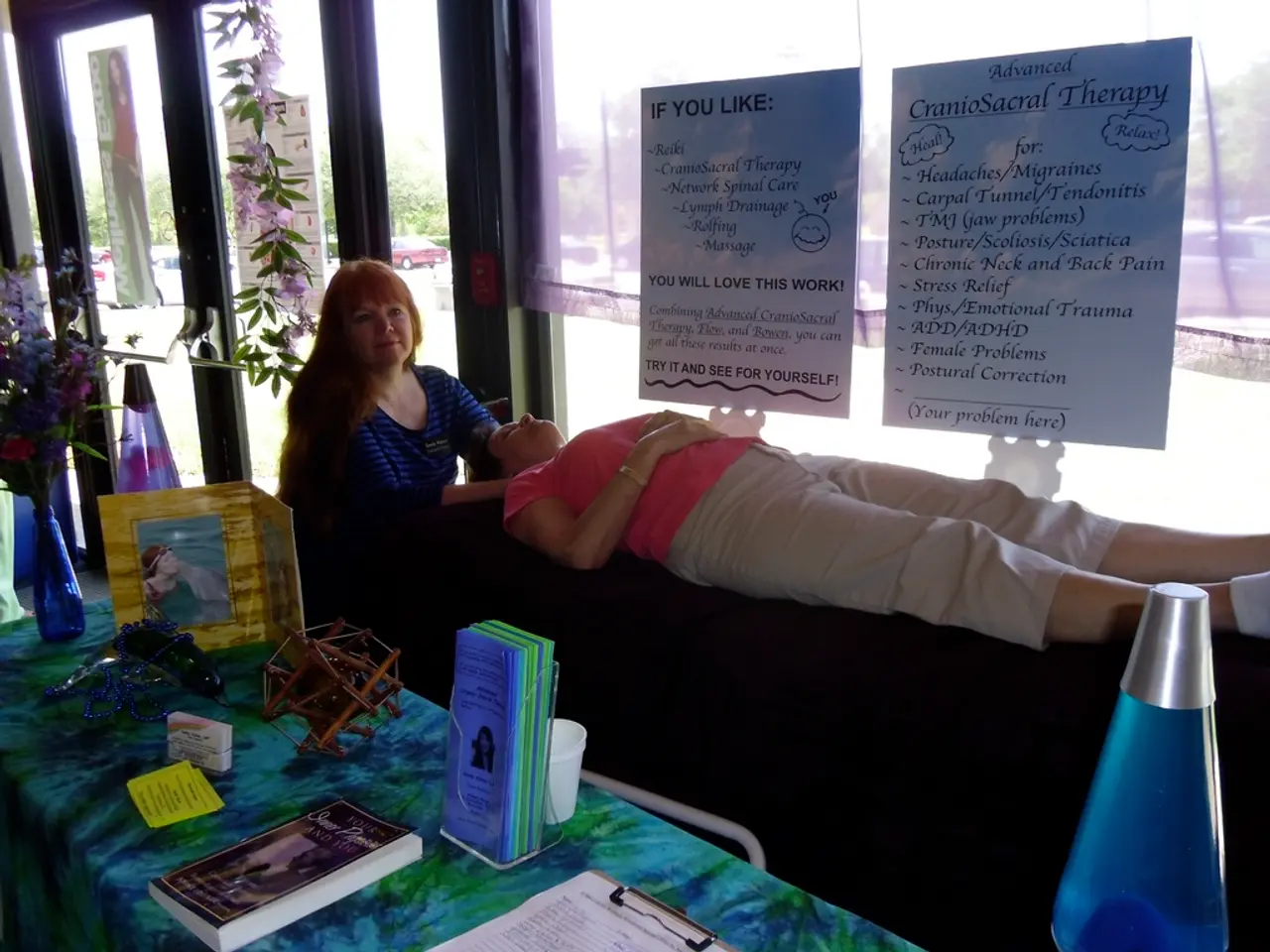Back discomfort: Origin, solutions, and when to consult a medical expert
Back pain is a common nuisance that can stem from various sources. You may find yourself grappling with this discomfort due to issues in your muscles, bones, ligaments, spinal cord, and even internal organs. Let's delve into the typical culprits and potential solutions for alleviating this pesky issue.
What causes back pain?
Injuries and sprains
Mishaps such as muscles or tendon strains, ligament sprains, whiplash, or fractures might trigger your agony. Any sudden movement like pushing, pulling, lifting, bending, twisting, coughing, or sneezing can result in these injuries.
Posture
How you hold yourself when sitting or standing can also contribute to back pain over time. Unhealthy postures such as:
- forward head posture (jutting the head forward over the spine)
- slouching (rounded shoulders)
- hyperlordosis (arching the lower back)
can be the silent villains in your back pain woes. Prolonged engagement in everyday activities like driving, using a low laptop or computer, sitting on unsupportive chairs, or sleeping on an inadequate mattress can also lead to poor posture.
Structural issues
Issues with the spine's structure may also bring about back pain. Some of these issues include:
- Ruptured or bulging disks: Disks situated between the spinal bones can herniate or bulge, putting pressure on nerves and potentially leading to sciatica (pain that travels through the buttock and down the back of a leg).
- Arthritis: This condition affects the joints in the hips, lower back, and other areas, narrowing the space around the spinal cord, a condition known as spinal stenosis.
- Osteoporosis: This bone-thinning condition, especially as people grow older, can lead to fractures, potentially causing back pain.
- Curvature of the spine: Scoliosis, a condition where the spine curls sideways, can also bring forth back pain.
Other causes
Various other factors can lead to back pain, including:
- kidney stones
- menstrual cramps
- endometriosis
- pregnancy
- infections of the bladder, kidneys, reproductive system, or spine
- shingles
- cauda equina syndrome
- cancer of the spine
What are the symptoms of back pain?
Back pain can present itself in various forms, locations, and intensities. For example:
- muscular pain may feel achy, tight, or like a spasm
- nerve pain may cause a stabbing, burning, or shooting sensation
- bone pain may feel deep and dull
Pain from certain back issues can also manifest itself in other areas, for example, sciatica may affect the legs.
A person with back pain may experience difficulty sitting or standing, difficulty putting weight on one or both legs, pain when moving in certain ways, or trouble sleeping.
When should you seek medical help?
If your back pain persists despite rest, follows an injury or fall, is accompanied by weakness, tingling or "pins and needles," unexplained weight loss, fever, incontinence, sudden difficulty urinating or having bowel movements, numbness, a lump or swelling on the back, or any other concerning symptoms, you should seek medical attention immediately.
Treatment for back pain
The course of treatment for back pain depends on its cause and severity. Treatment options range from home remedies and physical therapy to medications, injections, spinal manipulation, or even surgery in severe cases.
Prevention of back pain
Regular exercise, proper posture, supporting bone health, maintaining a moderate weight, lifting and moving safely, wearing supportive shoes, and using a supportive mattress can contribute to a lower risk of back pain.
As sunlight dances through the window, painting vibrant hues on the walls, remember to condition your body to combat the perils that lurk within the shadows waiting to ambush your back. A healthy lifestyle with a little bit of detective work to unravel the clues of your aching back can help you navigate the labyrinth of pain and lead you to the promise of relief and comfort.
- Injuries such as muscle or tendon strains, ligament sprains, whiplash, or fractures can cause back pain.
- Poor posture, like forward head posture, slouching, or hyperlordosis, can contribute to long-term back pain.
- Structural issues, like ruptured or bulging disks, arthritis, osteoporosis, or curvature of the spine (scoliosis), can also lead to back pain.
- Other causes of back pain include kidney stones, menstrual cramps, endometriosis, pregnancy, infections, shingles, cauda equina syndrome, cancer of the spine, and colitis.
- Back pain can manifest as muscular pain, nerve pain, or bone pain, and pain from certain back issues can affect other areas, like sciatica causing leg pain.
- Symptoms of back pain might include difficulty sitting or standing, difficulty putting weight on one or both legs, pain when moving in certain ways, or trouble sleeping.
- Seek immediate medical attention if back pain persists, is followed by injury or fall, is accompanied by weakness, tingling, unexplained weight loss, fever, incontinence, difficulty urinating or having bowel movements, numbness, a lump or swelling on the back, or any other concerning symptoms.
- The treatment for back pain depends on its cause and severity, ranging from home remedies to physical therapy, medications, injections, spinal manipulation, or surgery in severe cases.
- Prevention of back pain includes regular exercise, proper posture, supporting bone health, maintaining a moderate weight, lifting and moving safely, wearing supportive shoes, and using a supportive mattress.
- Type 1 diabetes and obesity increase the risk of back pain due to cardiovascular health issues.
- Therapies and treatments for various health and wellness conditions, such as multiple sclerosis and asthma, may indirectly contribute to back pain.
- Ankylosing spondylitis, a type of arthritis, can cause back pain and potentially lead to chronic kidney disease.
- Chronic diseases like HIV, chronic kidney disease, and chronic obstructive pulmonary disease (COPD) can exacerbate or cause back pain.
- Eczema, psoriasis, and other skin conditions may cause muscle pain and contribute to back pain due to constant scratching or itching.
- Science and medical advancements continue to uncover new information about chronic diseases, mental health, and back pain, with the ultimate goal of improving therapies and treatments and enhancing overall well-being.
- A well-rounded approach to fitness and exercise, nutrition, and mental health can help combat back pain and improve overall health and wellness.





